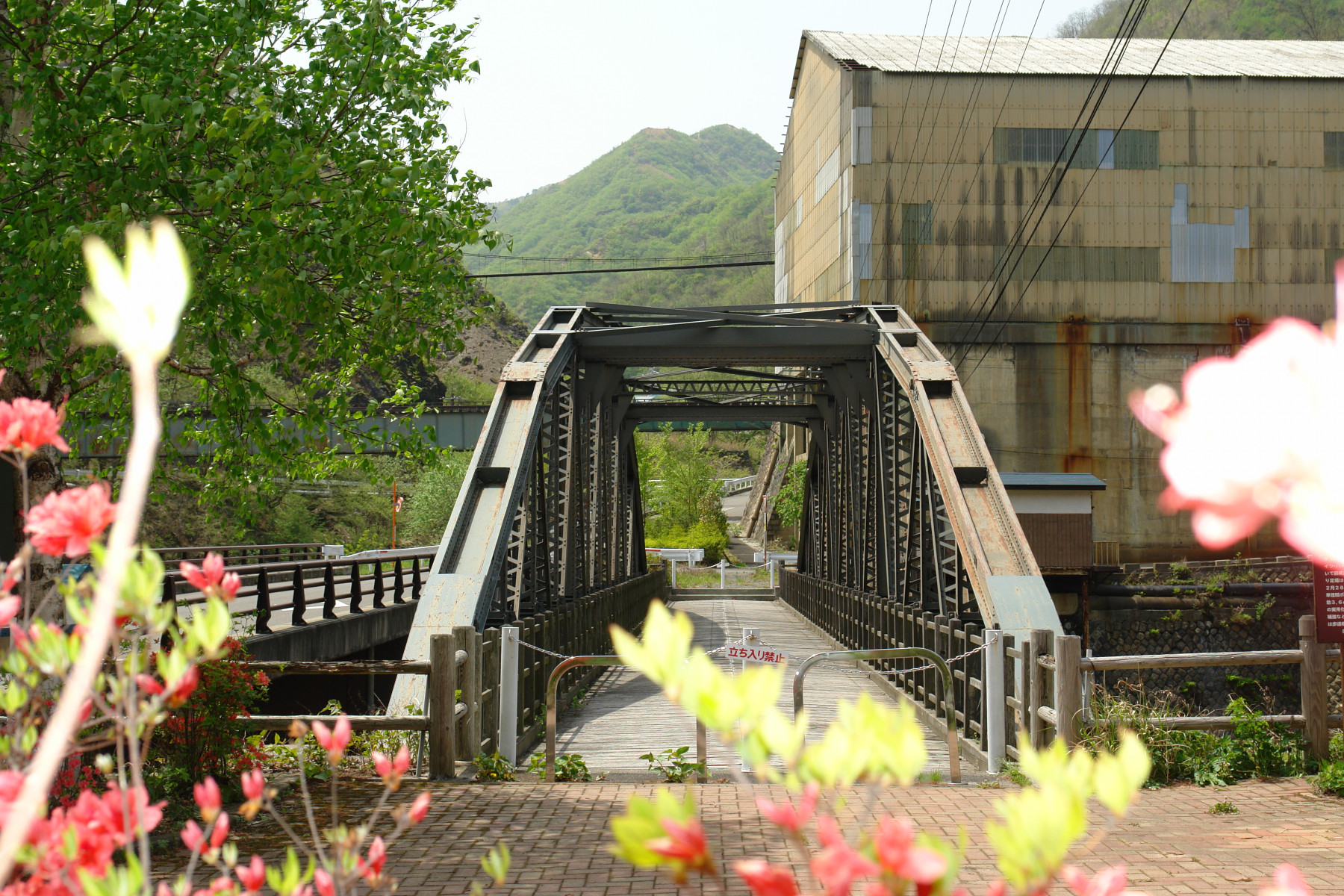産業遺産の見どころ
全山運動会 柏木平運動場1925・選鉱グラウンド1926~1932・柏木平運動場1933~1942 ALL ASHIODOZAN FESTIVAL 1925~1942
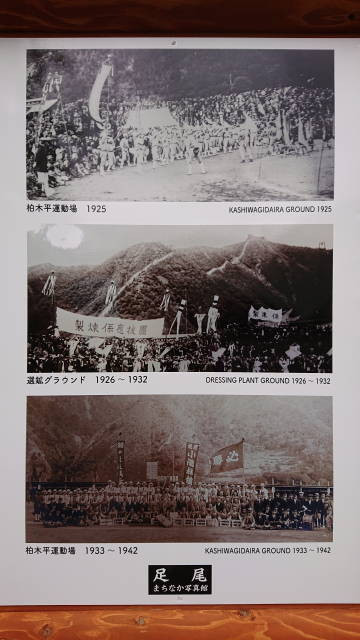
山で働く人々の暮らしを守るために、大正8年と10年に大規模な労働争議が足尾で起こりました。大正13年に足尾銅山体育会が発足し、人々のエネルギーは全山運動会で発揮されることになりました。最初、柏木平で開かれ、通洞の選鉱グラウンドで開催されましたが手狭で困ったようで、1932昭和7年に柏木平に1周200メートルのグラウンドを完成させ翌年から大規模な運動会が開催されました。
全山とは、坑口がある本山坑・小滝坑・通洞坑を合わせた総称です。応援歌は東京六大学応援歌のメロディに別の歌詞をつけましたが、当時はそれが主流だったようで各地で応援歌や校歌に転用されたそうです。青軍の応援歌は正に早稲田大学、他にも慶応、明治と全部で8軍あったそうです。オリジナルも当然あって、小滝の応援歌は労働運動家の生田龍作作詞、佐野金太郎作曲の素敵な曲です。
To protect the livelihood of those working in the mountains, large-scale labor disputes took place in Ashio in 1919 and 1921. In 1924, the Ashio Copper Mine Athletic Association was established, and the people's energy was demonstrated at the Zenzan Athletic Meet. The first athletic meet was held at Kashiwagidaira, and the following year it was held at the concentrator ground in Tsudo, but the ground was too small. In 1932, a 200-meter perimeter ground was completed at Kashiwagidaira, and a large-scale athletic meet had been held there since the following year.
Zenzan is the collective name for the mine mouths of the Honzan, Kodaki, and Tsudo tunnels. The cheering songs were based on the melody of the Tokyo Six University Cheering Songs with different lyrics. At that time, that was the mainstream, and they were converted into cheering songs and school songs in many places. The Blue team's cheering song was Waseda University’s. We also had Keio University, Meiji University, and eight universities in total. Of course, there were original songs as well, and Kodaki's cheering song was a wonderful song with lyrics by Ryu Ikuta, a labor activist, and music by Kintaro Sano.
旧足尾銅山労働組合 OLD THE LABOR UNION OFFICE OF ASHIO COPPER MAIN 1972
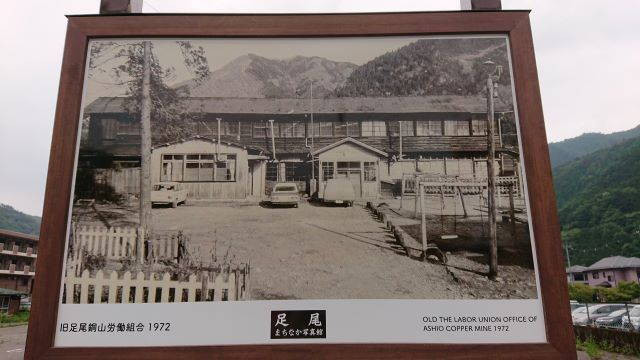
明治期の労働組合は、大日本労働至誠会事務所と言い、その巨頭は南助松と永岡鶴蔵です。永岡は、夕張から東京を経由して足尾に入り、坑夫の自立と独立を求める運動を展開、坑夫をやめ赤沢の前原で雑貨商を営みながら組織化を進めていきましたが妨害が多く衰退しました。それを打開するため夕張時代の盟友・南が明治9年10月に足尾に着いて戦闘的な方針を出して活発な活動を展開しました。
明治40年2月4日通洞で暴動が起き本山へも波及しました。見張りの破壊、採鉱役員に対する暴行は、役員が坑夫からの賄賂に応じて間代や切羽を変え、結果的に賃金支払いを左右していた事実を不公平だと感じていたことを示すものです。
さらに、当時の鉱業所長が鉱毒予防工事の官僚のひとり南禎三で、これまで多少のサボりも見逃し給料も減額無しであったスタンスを変え、厳格な処罰の上、給料カット方式を採用し、自分では私腹を肥やしていったことへの反感で狙われ乱打されましたが、殺すな、病院に連れていけとの声がかかり病院に担ぎ込まれたとありますが2週間で仕事に復帰しているそうです。通洞駅前の置屋に逃げ込み一命を取り留めたと云われていますがここで養生していたのではないでしょうか。おそらく日本最初の天下りではないでしょうか?
永岡と南は、坑夫の暴挙を抑えて地道な組織活動を行うように説得しましたが、警察がこれまでの態度を変えて患部を一斉に検挙し直ぐに宇都宮へ護送したため統制を失い、本山事務所の焼き討ちへと発展しました。この騒動は手の付けられない騒ぎに発展し、軍隊の出動が要請され高崎から三個中隊約300名の軍隊が足尾に着きました。裁判の結果、永岡と南ら幹部の大多数は無罪となりました。
時を経て、戦後の労働組合は、昭和20年12月に約3500人の組合員を集めて結成されました。職場別に10組合の連合体です。初代会長に、生田龍作で小滝の飯場頭二代目でしたが、明治・大正・昭和初期までの労働組合の伝統を受け継ぎ、戦後の民主化のために先頭に立って活躍しました。全日本金属鉱山労働組合連合会や栃木県労働組合会議の結成を主導しいずれも初代委員長を歴任しました。敗戦直後の食糧危機には町ぐるみの生き残り運動・鉱山の職業病である珪肺の絶滅を国家補償を求める決議を行い、昭和30年に珪肺特別法の成立に終始尽力した蘇原松次郎氏など戦後史に残る人物を輩出しました。
組合は、昭和48年2月の閉山に伴い解体され足尾銅山生活協同組合通洞売店が移転されましたが、それも閉店しました。
FORMER LABOR UNION OFFICE OF ASHIO COPPER MINE 1972
The labor union in Meiji era was called the The Great Japan Union Shiseikai Office, and the head of the union were Minami Sukematsu and Nagaoka Tsuruzou. Nagaoka has entered Ashio from Yubari via Tokyo, and during the travel he raised a movement for the independence of miners. After he quits mining, he attempted to form an organization while running a small business, however the movement has decayed due to many defense reactions. In order to overcome the defense, Minami who was a close friend of Nagaoka from Yubari, arrived in Ashio in October 1897 and put out a combative policy and exhibited activities.
On February 4, 1890, a riot broke out and spread to Honzan. The destruction of the lookout and the black line against the mining officer revealed the frustration of miners towards its unfair treatment to their salary, which was the frequent change in officers’ clonus and the face with the bribe that miners had to offer.
In addition, the director of the mining industry at that time was Teizo Minami, one of the bureaucrats of the mining defense test construction, and he changed the stance to no reduction in the salary and the headline, and the punishment was remarkable. He adopted a salary cut method to line his own pocket. Due to these behaviors, he has provoked miner’s antipathy and was targeted to violence. However, some told not to kill him, and he has returned to work in 2 weeks after being carried to the hospital. He has escaped into a cathouse in front of the Tsudo station, and barely saved his life, which cathouse is likely to be the one existed right here. This may be the first case of rotating-door (Amakudari) in Japan.
Nagaoka and Minami persuaded people to pause the aggressive riot to the miners, and instead work as an organization in an honest way. However, because the police changed their attitude and arrested the executives to be deported to Utsunomiya, the Honzan office was put on fire. This turmoil was out of control, and the military was sent out that about 300 troops came from Takasaki to Ashio. The adjudgment told the majority of executives including Nagaoka and Minami are acquitted.
Afterwards, the postwar labor union was formed in December 1945 by gathering about 3,500 members. 10-set of unions were formed for each workplace. The first chairman was Ikuta Ryusaku who was the second generation of Iba family from Kodaki, He took the lead in the postwar democratization by following the tradition of the labor union until the Meiji, Taisho and early Showa eras. He led the formation of the All Japan Metal Mining Labor Union Federation and the Tochigi Prefecture Labor Union Council, both of which he served as its first chairpersons. In the food crisis immediately after the defeat of war, he started the town-wide survival movement and the movement to seek national compensation for the reduction of silicosis that were spread across miners.
In 1955, all efforts were made to enact the Special Law for Silicosis. Matsujirou Suhara has made his name in the postwar history for his great effort in the movement around the illness. The union was dismantled due to the closure of the mountain in February 1948. Ashio Dozan Consumers' Co-op store was relocated along with the closure of the mine, but also to be closed afterwards.
ガソリンカー軌道跡 OLD TRACK MARK OF GASOLINE CAR 1926~1954
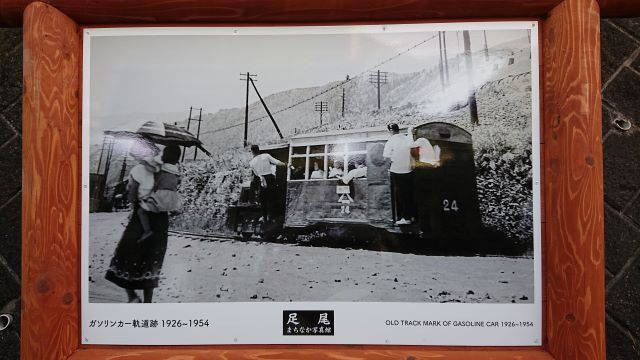
足尾の運搬技術は、その時代の最先端を先導する形で取り入れられてきました。
1649年から江戸時代の銅の運搬は、足尾から群馬県の峠道を越えて、渡良瀬川沿いに銅街道(あかがねかいどう)を馬に背負わせて途中途中の銅蔵にて休み休み利根川岸まで運び、江戸まで運んでいました。宿は沢入・花輪・桐原・大原本町・亀岡。
明治10年に古河市兵衛が足尾銅山を手に入れると、渡良瀬の停車場を基点に馬車鉄道が敷かれ、また索道を通して日光側へ下ろしまた馬車鉄道で日光駅へ運び鉄道で東京へと運ばれました。まちなかのインフラは右往左往に馬車鉄道が敷かれ、大正時代に入ると馬車からガソリンカーへ変わりました。当時は、横浜港にアメリカからフォード車が次々と輸入された時代・・・これに目を付けた古河三代目虎之助は、フォードのエンジンを搭載したガソリンカーを13台造らせ、また資材運搬用として一回り大きな21・22号を造らせました。
ガソリンカーは、大正15年から昭和29年3月までの30年間足尾の足となって活躍しました。銅山の街足尾町の主要道路にはトロッコ用資材なども運搬していましたが、鉱石は別ルートで運ばれていたので、この町中にあった軌道に鉱石運搬列車は走っていませんでした。やがてトラック輸送に置き換えられ、足尾町名物?のようなトロッコ風ミニ列車は廃止されましたが、その走っていた頃を懐かしむ人々の強い願いによってガソリンカーとして完全復元され、現在、14番目のガソリンカーが古河足尾歴史館トロッコ館にて再現されみなさまをお迎えしております。4月~11月の毎月第一土・日に定期運行しています。
Gasoline car track ruins
Ashio's transportation had adopted the leading technology of each era.
From 1649 to the Edo period, copper was transported on horses on the Akagane road along the Watarase River from Ashio over a mountain pass to Gunma Prefecture. The copper was carried to the bank of the Tone River, resting at copper warehouses along the way, and then transported to Edo (now Tokyo).
The stops were Sori, Hanawa, Kirihara, Ohara-honcho, and Kameoka. When Ichibe Furukawa acquired the Ashio Copper Mine in 1877, a horse-drawn wagon railroad was built from the Watarase stop, and copper was unloaded at the Nikko side via a cableway and transported by horse-drawn wagon railroad to Nikko Station and then to Tokyo by rail. The city's infrastructure was laid out with horse-drawn railroads all over the city, and in the Taisho era (1912-1926), horse-drawn carriages were replaced by gasoline-powered cars.
At that time, Ford cars were imported one after another from the U.S. to the port of Yokohama. Toranosuke Furukawa took notice of this and had 13 gasoline cars with Ford engines built, as well as the larger No. 21 and No. 22 for transporting materials.
The miniature trolley-style train, which was a specialty of Ashio, was eventually replaced by truck transportation, and the trolley-style mini-train was discontinued. The 14th miniature trolley-style train has been fully restored as a gasoline car in response to the strong wishes of people who long for the days when miniature trolley-style trains used to run. It operates regularly on the first Saturday and Sunday of every month from April to November at Trolley-style train Museum in Furukawa Historical Museum, welcoming all tourists.
簀子橋 SUNOKO BRIGE OF THE ORIGIN OF THE ASHIO COPPER MINE MEIJI YEAR
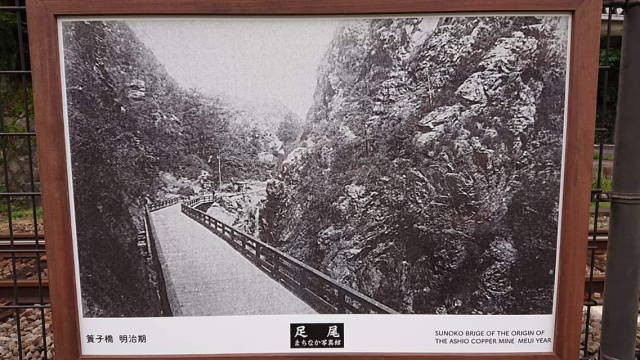
簀子橋が開けたのは、慶長15年・・・1610年5月に足尾郷の農民治部(じぶ)と内蔵(くら)が渋川の上流の黒岩山の中腹で銅の露頭を発見したとされる伝承からです。
二人は発見を日光座禅院座主に報告し、試掘の許可を得ます。社殿を建立し大山祇神を祀り山神とし新坑の安泰と産銅の繁栄を祈願しました。翌年、座禅院を通して時の将軍徳川家康の三代目家光の5歳の着袴の儀(七五三)に奉納したことをきっかけに幕府直轄の銅山として260年の徳川を支えていくことになりました。座主は二人の功績を祈念して黒岩山を備前楯山に改名したと云われます。備前は彼らの故郷であり楯は鉱脈を意味することからの命名だと云われます
そのルートは、渋川左岸を川沿いに進み不動滝に桟橋を架けて右岸に渡り、その上流の沢や尾根筋で露頭をとらえ開発が開始されました。不動滝手前からチャートが露出した断崖になっていて道路を開くのが困難だったため右岸川底に丸太で柱を立て、梁を乗せ、綱木で固定してその上に板張りをする岸壁の橋を造りました。これを簀子橋と呼んだことから地名にもなりました。
簀子橋は江戸時代の鉱山基地として栄え、松原には銅山奉行の陣屋が出来ました。1742年から1747年にかけて足の字が彫られた足字銭と云われる一文銭が鋳造されました。簀子橋には、神山清右衛門や福田直右衛門と言った代々受け継ぐ山師がおりましたが、明治期にはそれぞれ名主になっています。なかでも神山清右ヱ門は1742年に足字銭鋳造を祈念して狛犬を一対奉納していますが、使われた石は頑強で、足尾の石を使って彫ったとの記録があります。何回もの水害にも屈せず、270年余りの時を経ても未だに欠けることなくその存在を誇示しています。また、研究家の間でも日本全国何処にも見られない珍しい狛犬だとの評判を頂いています。
明治22年には100戸以上の鉱山集落も出来、別子銅山から来山しベッセマー転炉を考案した技師塩野門之助の家族も住んでいましたが、明治24年の大洪水で社宅の一部が流され門之助の奥さんと子供さんも犠牲になりました。明治35年の足尾台風では社宅の大半と家族78人が流され、そのうち7人が足尾小学校校庭に打ち上げられる大参事になりました。その後、雑夫長屋18棟・見張所・変圧所が再建されましたが、大正12年に出合坑閉鎖に伴い撤収されました。
山神社の御神体と狛犬は、大正9年に通洞鉱山神社に遷座されています。
因みに、不動滝は日光山開山の勝道上人が、男体山登頂するための修業の場所のひとつであり、不動明王が置かれています。その後の山岳修業の地であります。
昭和35年の第一期護岸工事を手掛けた飛島建設の現場監督が、土砂に埋もれていた不動明王を見つけ出し綺麗に洗い清めて山腹側に祀ったそうです。護岸工事は事故もなく無事に完成したそうです。現場監督は、立派な不動明王が気になって仕方なく手紙にしたためましたが、かなりの時を経て当サイトの管理者の手に入ることになりました。調査をしたところ、古河の足尾事業所鉱務課が管理をしておりました。簀子ダムの安全祈願のために、毎年、祠と不動明王を綺麗に掃除をしてお酒を上げているとのことでした。ダムが建設されてから、一度も事故もなく来られたことは、当時の現場監督のお陰だと言っても過言ではなく、これで安らかに眠っていただけると思います。
SUNOKO BRIGE; THE ORIGIN OF THE ASHIO COPPER MINE MEIJI YEAR
The establishment of Sunoko Bridge goes back to the story of when the peasants Jibu and Kura from Ashio discovered the outcrop of copper in the middle title of Mount Kuroiwa in the upper pool of Shibukawa river in May 1610.
They reported the discovery to the owner of Nikko-Zazen-Inn and get a permission for trial digging. They built the shrine and deified Oyama God as a god for the mountains and prayed for the peace with the new pit and prosperity of mine.
The year after, via Zazen-Inn, they dedicated a gift to Tokugawa Iemitsu; the Third generation of Tokugawa, for his 5years-old kimono ceremony. The mine supported Tokugawa for the next 260 years as a mountain under the direct control of its government. The head of the temple renamed Mt. Kuroiwa to Bizen-Tateyama, in respect to the achievement of the two. The name was derived from the fact that the “Bizen” is their hometown and “Tate” means the mineral vein. Development started from catching the outcrop in the upstream swamps and ridge trail. The route follows along the left side of Shibu river and crossing to the right side at the bridge located in Fudou waterfall.
Due to a cross section with a chart coming out from the front of the waterfall it was difficult to pull the road. A pillar was erected with a log on the right side of the river and a beam was placed on it. The bridge was fixed with a perimeter tree with timber on top. The name of the area was retrieved from the name of the bridge; Sunoko-Bashi. Sunoko-Bashi prospered as a mining base in the Edo period, and a camp for the same floats was built in Matsubara. From 1742 to 1747, Ashijisen; coins with the letter “foot” engraved were produced. There were charlatans that continued for generations such as 神山清右衛門and福田直右衛門, , but they became masters in the Meiji era. Especially, 神山清右衛門 has dedicated a pair of guardian dogs as a memorial for Ashijisen in 1742, which was told to be engraved using the stone of Ashio. The bridge has endured water disasters repeatedly, even after 270 years of its life, the presence of the bridge is still strong. The guardian dogs considered to be rare kind by the researchers which is barely seen anywhere in Japan.
In Meiji 22, over 100 households were made in mine village, and the family of Monnosuke Shiono, a technician who considered the Bessemer transfer from Besshi-dozan to Higashiyama, also lived there. However, they were victimized from the Ashio typhoon of 1902, where the most of the company housing and 78 civilian employees were washed away, and 7 of them were launched into the Ashio Elementary School playground. Later, 18 of labor housing, an observation station, and a transformer substation were re-constructed, but in 1918, they were demolished as the closure of the pit.
The body of gods and the gradian dogs of Sanjin-Shrine were transported to Tsudo Mining Shrine in 1918.
Incidentally, Fudo waterfall is one of the training places for Shodo Shonin to reach the summit of Mt. Nantai, and Fudo-Myo-Ou is placed there. This is what is to be used for mountain ascetic practice later.
波之利大黒天 HASHIRIDAIKOKUTEN NARA YEAR
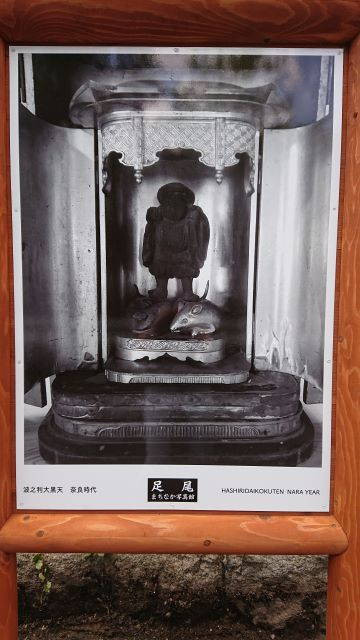
日光山開山の勝道上人が、足尾に入り橋のない川を渡ろうと浅瀬を探して渡ったとしてこの地を渡良瀬・川を渡良瀬川と命名したと云われています。
この渡良瀬に宝増寺が建立されたのが786年(延暦7年)に伝教大師最澄の創立と伝えられており、後に天台宗となりました。
渡良瀬には、1716~1736年の享保年間まであり大黒橋付近から橋を渡ってお寺の門を潜ったそうです。赤沢の現在地に、1688~1703年の元禄年間に本院が建立され、渡良瀬は別院となったようです。
赤沢のこの地は明治元年に僧茂海が本堂を建立し、大正10年には檀家で修復が行われています。足尾第一の檀家を持ち、火災に遭わなかったため寺宝が残っています。
大黒橋の上人が彫ったとされる波之利大黒天があり、現在は、この本堂に安置されています。
足尾の由来は、
むかしむかし、勝道上人というお坊さまがおったそうな!中禅寺湖のほとりの寺で修業をしていると、毎年粟の穂を口にくわえて現れる一匹の白ねずみがおったそうな!ある日その後をついていくと何とその山奥には村があったそうな!そこで上人はその村を「足緒」と名づけたそうな!その時の白ねずみを祀ったのが宝増寺にある波之利大黒天だとさ!
HASHIRIDAIKOKUTEN NARA PERIOD
The area was named Watarase and the river was named Watarasegawa after Shodo Shonin, the superior of Nikko-Kaizan, attempting to cross the shallows in the river without crossing a bridge.
It is said that Hozoji Temple was built in Watarase in 786 (7th year of the Ensho calendar), and later became the Tendai sect. In Watarase, the temple was in Watarase from 1716 to 1736 during the Kyoho period, and people dived into the temple gate crossing the Daikoku Bridge.
At the present location of Akasawa, the main temple was established during the Genroku era from 1688 to 1703, and Watarase have become an extensional temple.
In the first year of the Meiji era, the main hall was built in this area of Akasawa by the monk Mokai, and in the 10th year of the Taisho era, it was restored by the Danka. Thanks to the most prestigious Danka in Ashio, the temple treasure remains to this day without getting damaged by fire.
There is Hashiri Daikokuten, which is carved by the superior of DAIKOKU Bridge, and is currently enshrined in this main hall.
The story of origin of Ashio;
Once upon a time, there was a priest named Shodo Shonin!
When he was training at a temple on the shores of Lake Chuzenji, a white mouse appeared with a spray of millet in its mouth every year.
One day the monk followed the mouse, and there was a village in the mountains.
He named the village "Ashio; A string attached to the hawk's leg used for falconry”.
The white mouse is enshrined in the Hashirii Daikokuten in Hozoji Temple!
